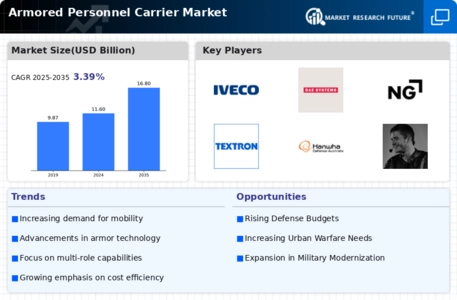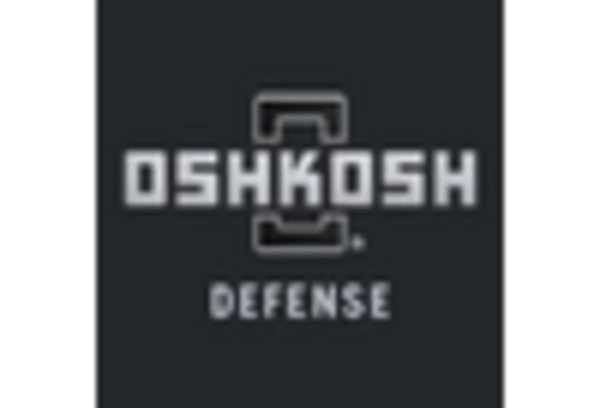-
EXECUTIVE SUMMARY
-
Market Overview
-
Key Findings
-
Market Segmentation
-
Competitive Landscape
-
Challenges and Opportunities
-
Future Outlook
-
MARKET INTRODUCTION
-
Definition
-
Scope of the study
- Research Objective
- Assumption
- Limitations
-
RESEARCH METHODOLOGY
-
Overview
-
Data Mining
-
Secondary Research
-
Primary Research
- Primary Interviews and Information Gathering Process
- Breakdown of Primary Respondents
-
Forecasting Model
-
Market Size Estimation
- Bottom-Up Approach
- Top-Down Approach
-
Data Triangulation
-
Validation
-
MARKET DYNAMICS
-
Overview
-
Drivers
-
Restraints
-
Opportunities
-
MARKET FACTOR ANALYSIS
-
Value chain Analysis
-
Porter's Five Forces Analysis
- Bargaining Power of Suppliers
- Bargaining Power of Buyers
- Threat of New Entrants
- Threat of Substitutes
- Intensity of Rivalry
-
COVID-19 Impact Analysis
- Market Impact Analysis
- Regional Impact
- Opportunity and Threat Analysis
-
ARMOURED PERSONNEL CARRIER MARKET, BY APPLICATION (USD BILLION)
-
Military Operations
-
Civilian Protection
-
Peacekeeping Missions
-
Counter-Terrorism Operations
-
ARMOURED PERSONNEL CARRIER MARKET, BY ARMOUR TYPE (USD BILLION)
-
Composite Armour
-
Steel Armour
-
Ceramic Armour
-
Soft Armour
-
ARMOURED PERSONNEL CARRIER MARKET, BY VEHICLE CAPACITY (USD BILLION)
-
2-4 Personnel
-
5-10 Personnel
-
11-20 Personnel
-
21+ Personnel
-
ARMOURED PERSONNEL CARRIER MARKET, BY END USE (USD BILLION)
-
Defense Forces
-
Law Enforcement Agencies
-
Private Security
-
ARMOURED PERSONNEL CARRIER MARKET, BY REGIONAL (USD BILLION)
-
North America
- US
- Canada
-
Europe
- Germany
- UK
- France
- Russia
- Italy
- Spain
- Rest of Europe
-
APAC
- China
- India
- Japan
- South Korea
- Malaysia
- Thailand
- Indonesia
- Rest of APAC
-
South America
- Brazil
- Mexico
- Argentina
- Rest of South America
-
MEA
- GCC Countries
- South Africa
- Rest of MEA
-
COMPETITIVE LANDSCAPE
-
Overview
-
Competitive Analysis
-
Market share Analysis
-
Major Growth Strategy in the Armoured Personnel Carrier Market
-
Competitive Benchmarking
-
Leading Players in Terms of Number of Developments in the Armoured Personnel Carrier Market
-
Key developments and growth strategies
- New Product Launch/Service Deployment
- Merger & Acquisitions
- Joint Ventures
-
Major Players Financial Matrix
- Sales and Operating Income
- Major Players R&D Expenditure. 2023
-
COMPANY PROFILES
-
Navistar International
- Financial Overview
- Products Offered
- Key Developments
- SWOT Analysis
- Key Strategies
-
General Dynamics
- Financial Overview
- Products Offered
- Key Developments
- SWOT Analysis
- Key Strategies
-
KraussMaffei Wegmann
- Financial Overview
- Products Offered
- Key Developments
- SWOT Analysis
- Key Strategies
-
FNSS Defense Systems
- Financial Overview
- Products Offered
- Key Developments
- SWOT Analysis
- Key Strategies
-
Iveco
- Financial Overview
- Products Offered
- Key Developments
- SWOT Analysis
- Key Strategies
-
BAE Systems
- Financial Overview
- Products Offered
- Key Developments
- SWOT Analysis
- Key Strategies
-
Northrop Grumman
- Financial Overview
- Products Offered
- Key Developments
- SWOT Analysis
- Key Strategies
-
Textron
- Financial Overview
- Products Offered
- Key Developments
- SWOT Analysis
- Key Strategies
-
Hanwha Defense
- Financial Overview
- Products Offered
- Key Developments
- SWOT Analysis
- Key Strategies
-
COMPOSITE NA
- Financial Overview
- Products Offered
- Key Developments
- SWOT Analysis
- Key Strategies
-
Oshkosh Corporation
- Financial Overview
- Products Offered
- Key Developments
- SWOT Analysis
- Key Strategies
-
Lockheed Martin
- Financial Overview
- Products Offered
- Key Developments
- SWOT Analysis
- Key Strategies
-
Rheinmetall
- Financial Overview
- Products Offered
- Key Developments
- SWOT Analysis
- Key Strategies
-
Elbit Systems
- Financial Overview
- Products Offered
- Key Developments
- SWOT Analysis
- Key Strategies
-
Thales
- Financial Overview
- Products Offered
- Key Developments
- SWOT Analysis
- Key Strategies
-
APPENDIX
-
References
-
Related Reports
-
LIST OF TABLES
-
LIST OF ASSUMPTIONS
-
NORTH AMERICA ARMOURED PERSONNEL CARRIER MARKET SIZE ESTIMATES & FORECAST, BY APPLICATION, 2019-2032 (USD BILLIONS)
-
NORTH AMERICA ARMOURED PERSONNEL CARRIER MARKET SIZE ESTIMATES & FORECAST, BY ARMOUR TYPE, 2019-2032 (USD BILLIONS)
-
NORTH AMERICA ARMOURED PERSONNEL CARRIER MARKET SIZE ESTIMATES & FORECAST, BY VEHICLE CAPACITY, 2019-2032 (USD BILLIONS)
-
NORTH AMERICA ARMOURED PERSONNEL CARRIER MARKET SIZE ESTIMATES & FORECAST, BY END USE, 2019-2032 (USD BILLIONS)
-
NORTH AMERICA ARMOURED PERSONNEL CARRIER MARKET SIZE ESTIMATES & FORECAST, BY REGIONAL, 2019-2032 (USD BILLIONS)
-
US ARMOURED PERSONNEL CARRIER MARKET SIZE ESTIMATES & FORECAST, BY APPLICATION, 2019-2032 (USD BILLIONS)
-
US ARMOURED PERSONNEL CARRIER MARKET SIZE ESTIMATES & FORECAST, BY ARMOUR TYPE, 2019-2032 (USD BILLIONS)
-
US ARMOURED PERSONNEL CARRIER MARKET SIZE ESTIMATES & FORECAST, BY VEHICLE CAPACITY, 2019-2032 (USD BILLIONS)
-
US ARMOURED PERSONNEL CARRIER MARKET SIZE ESTIMATES & FORECAST, BY END USE, 2019-2032 (USD BILLIONS)
-
US ARMOURED PERSONNEL CARRIER MARKET SIZE ESTIMATES & FORECAST, BY REGIONAL, 2019-2032 (USD BILLIONS)
-
CANADA ARMOURED PERSONNEL CARRIER MARKET SIZE ESTIMATES & FORECAST, BY APPLICATION, 2019-2032 (USD BILLIONS)
-
CANADA ARMOURED PERSONNEL CARRIER MARKET SIZE ESTIMATES & FORECAST, BY ARMOUR TYPE, 2019-2032 (USD BILLIONS)
-
CANADA ARMOURED PERSONNEL CARRIER MARKET SIZE ESTIMATES & FORECAST, BY VEHICLE CAPACITY, 2019-2032 (USD BILLIONS)
-
CANADA ARMOURED PERSONNEL CARRIER MARKET SIZE ESTIMATES & FORECAST, BY END USE, 2019-2032 (USD BILLIONS)
-
CANADA ARMOURED PERSONNEL CARRIER MARKET SIZE ESTIMATES & FORECAST, BY REGIONAL, 2019-2032 (USD BILLIONS)
-
EUROPE ARMOURED PERSONNEL CARRIER MARKET SIZE ESTIMATES & FORECAST, BY APPLICATION, 2019-2032 (USD BILLIONS)
-
EUROPE ARMOURED PERSONNEL CARRIER MARKET SIZE ESTIMATES & FORECAST, BY ARMOUR TYPE, 2019-2032 (USD BILLIONS)
-
EUROPE ARMOURED PERSONNEL CARRIER MARKET SIZE ESTIMATES & FORECAST, BY VEHICLE CAPACITY, 2019-2032 (USD BILLIONS)
-
EUROPE ARMOURED PERSONNEL CARRIER MARKET SIZE ESTIMATES & FORECAST, BY END USE, 2019-2032 (USD BILLIONS)
-
EUROPE ARMOURED PERSONNEL CARRIER MARKET SIZE ESTIMATES & FORECAST, BY REGIONAL, 2019-2032 (USD BILLIONS)
-
GERMANY ARMOURED PERSONNEL CARRIER MARKET SIZE ESTIMATES & FORECAST, BY APPLICATION, 2019-2032 (USD BILLIONS)
-
GERMANY ARMOURED PERSONNEL CARRIER MARKET SIZE ESTIMATES & FORECAST, BY ARMOUR TYPE, 2019-2032 (USD BILLIONS)
-
GERMANY ARMOURED PERSONNEL CARRIER MARKET SIZE ESTIMATES & FORECAST, BY VEHICLE CAPACITY, 2019-2032 (USD BILLIONS)
-
GERMANY ARMOURED PERSONNEL CARRIER MARKET SIZE ESTIMATES & FORECAST, BY END USE, 2019-2032 (USD BILLIONS)
-
GERMANY ARMOURED PERSONNEL CARRIER MARKET SIZE ESTIMATES & FORECAST, BY REGIONAL, 2019-2032 (USD BILLIONS)
-
UK ARMOURED PERSONNEL CARRIER MARKET SIZE ESTIMATES & FORECAST, BY APPLICATION, 2019-2032 (USD BILLIONS)
-
UK ARMOURED PERSONNEL CARRIER MARKET SIZE ESTIMATES & FORECAST, BY ARMOUR TYPE, 2019-2032 (USD BILLIONS)
-
UK ARMOURED PERSONNEL CARRIER MARKET SIZE ESTIMATES & FORECAST, BY VEHICLE CAPACITY, 2019-2032 (USD BILLIONS)
-
UK ARMOURED PERSONNEL CARRIER MARKET SIZE ESTIMATES & FORECAST, BY END USE, 2019-2032 (USD BILLIONS)
-
UK ARMOURED PERSONNEL CARRIER MARKET SIZE ESTIMATES & FORECAST, BY REGIONAL, 2019-2032 (USD BILLIONS)
-
FRANCE ARMOURED PERSONNEL CARRIER MARKET SIZE ESTIMATES & FORECAST, BY APPLICATION, 2019-2032 (USD BILLIONS)
-
FRANCE ARMOURED PERSONNEL CARRIER MARKET SIZE ESTIMATES & FORECAST, BY ARMOUR TYPE, 2019-2032 (USD BILLIONS)
-
FRANCE ARMOURED PERSONNEL CARRIER MARKET SIZE ESTIMATES & FORECAST, BY VEHICLE CAPACITY, 2019-2032 (USD BILLIONS)
-
FRANCE ARMOURED PERSONNEL CARRIER MARKET SIZE ESTIMATES & FORECAST, BY END USE, 2019-2032 (USD BILLIONS)
-
FRANCE ARMOURED PERSONNEL CARRIER MARKET SIZE ESTIMATES & FORECAST, BY REGIONAL, 2019-2032 (USD BILLIONS)
-
RUSSIA ARMOURED PERSONNEL CARRIER MARKET SIZE ESTIMATES & FORECAST, BY APPLICATION, 2019-2032 (USD BILLIONS)
-
RUSSIA ARMOURED PERSONNEL CARRIER MARKET SIZE ESTIMATES & FORECAST, BY ARMOUR TYPE, 2019-2032 (USD BILLIONS)
-
RUSSIA ARMOURED PERSONNEL CARRIER MARKET SIZE ESTIMATES & FORECAST, BY VEHICLE CAPACITY, 2019-2032 (USD BILLIONS)
-
RUSSIA ARMOURED PERSONNEL CARRIER MARKET SIZE ESTIMATES & FORECAST, BY END USE, 2019-2032 (USD BILLIONS)
-
RUSSIA ARMOURED PERSONNEL CARRIER MARKET SIZE ESTIMATES & FORECAST, BY REGIONAL, 2019-2032 (USD BILLIONS)
-
ITALY ARMOURED PERSONNEL CARRIER MARKET SIZE ESTIMATES & FORECAST, BY APPLICATION, 2019-2032 (USD BILLIONS)
-
ITALY ARMOURED PERSONNEL CARRIER MARKET SIZE ESTIMATES & FORECAST, BY ARMOUR TYPE, 2019-2032 (USD BILLIONS)
-
ITALY ARMOURED PERSONNEL CARRIER MARKET SIZE ESTIMATES & FORECAST, BY VEHICLE CAPACITY, 2019-2032 (USD BILLIONS)
-
ITALY ARMOURED PERSONNEL CARRIER MARKET SIZE ESTIMATES & FORECAST, BY END USE, 2019-2032 (USD BILLIONS)
-
ITALY ARMOURED PERSONNEL CARRIER MARKET SIZE ESTIMATES & FORECAST, BY REGIONAL, 2019-2032 (USD BILLIONS)
-
SPAIN ARMOURED PERSONNEL CARRIER MARKET SIZE ESTIMATES & FORECAST, BY APPLICATION, 2019-2032 (USD BILLIONS)
-
SPAIN ARMOURED PERSONNEL CARRIER MARKET SIZE ESTIMATES & FORECAST, BY ARMOUR TYPE, 2019-2032 (USD BILLIONS)
-
SPAIN ARMOURED PERSONNEL CARRIER MARKET SIZE ESTIMATES & FORECAST, BY VEHICLE CAPACITY, 2019-2032 (USD BILLIONS)
-
SPAIN ARMOURED PERSONNEL CARRIER MARKET SIZE ESTIMATES & FORECAST, BY END USE, 2019-2032 (USD BILLIONS)
-
SPAIN ARMOURED PERSONNEL CARRIER MARKET SIZE ESTIMATES & FORECAST, BY REGIONAL, 2019-2032 (USD BILLIONS)
-
REST OF EUROPE ARMOURED PERSONNEL CARRIER MARKET SIZE ESTIMATES & FORECAST, BY APPLICATION, 2019-2032 (USD BILLIONS)
-
REST OF EUROPE ARMOURED PERSONNEL CARRIER MARKET SIZE ESTIMATES & FORECAST, BY ARMOUR TYPE, 2019-2032 (USD BILLIONS)
-
REST OF EUROPE ARMOURED PERSONNEL CARRIER MARKET SIZE ESTIMATES & FORECAST, BY VEHICLE CAPACITY, 2019-2032 (USD BILLIONS)
-
REST OF EUROPE ARMOURED PERSONNEL CARRIER MARKET SIZE ESTIMATES & FORECAST, BY END USE, 2019-2032 (USD BILLIONS)
-
REST OF EUROPE ARMOURED PERSONNEL CARRIER MARKET SIZE ESTIMATES & FORECAST, BY REGIONAL, 2019-2032 (USD BILLIONS)
-
APAC ARMOURED PERSONNEL CARRIER MARKET SIZE ESTIMATES & FORECAST, BY APPLICATION, 2019-2032 (USD BILLIONS)
-
APAC ARMOURED PERSONNEL CARRIER MARKET SIZE ESTIMATES & FORECAST, BY ARMOUR TYPE, 2019-2032 (USD BILLIONS)
-
APAC ARMOURED PERSONNEL CARRIER MARKET SIZE ESTIMATES & FORECAST, BY VEHICLE CAPACITY, 2019-2032 (USD BILLIONS)
-
APAC ARMOURED PERSONNEL CARRIER MARKET SIZE ESTIMATES & FORECAST, BY END USE, 2019-2032 (USD BILLIONS)
-
APAC ARMOURED PERSONNEL CARRIER MARKET SIZE ESTIMATES & FORECAST, BY REGIONAL, 2019-2032 (USD BILLIONS)
-
CHINA ARMOURED PERSONNEL CARRIER MARKET SIZE ESTIMATES & FORECAST, BY APPLICATION, 2019-2032 (USD BILLIONS)
-
CHINA ARMOURED PERSONNEL CARRIER MARKET SIZE ESTIMATES & FORECAST, BY ARMOUR TYPE, 2019-2032 (USD BILLIONS)
-
CHINA ARMOURED PERSONNEL CARRIER MARKET SIZE ESTIMATES & FORECAST, BY VEHICLE CAPACITY, 2019-2032 (USD BILLIONS)
-
CHINA ARMOURED PERSONNEL CARRIER MARKET SIZE ESTIMATES & FORECAST, BY END USE, 2019-2032 (USD BILLIONS)
-
CHINA ARMOURED PERSONNEL CARRIER MARKET SIZE ESTIMATES & FORECAST, BY REGIONAL, 2019-2032 (USD BILLIONS)
-
INDIA ARMOURED PERSONNEL CARRIER MARKET SIZE ESTIMATES & FORECAST, BY APPLICATION, 2019-2032 (USD BILLIONS)
-
INDIA ARMOURED PERSONNEL CARRIER MARKET SIZE ESTIMATES & FORECAST, BY ARMOUR TYPE, 2019-2032 (USD BILLIONS)
-
INDIA ARMOURED PERSONNEL CARRIER MARKET SIZE ESTIMATES & FORECAST, BY VEHICLE CAPACITY, 2019-2032 (USD BILLIONS)
-
INDIA ARMOURED PERSONNEL CARRIER MARKET SIZE ESTIMATES & FORECAST, BY END USE, 2019-2032 (USD BILLIONS)
-
INDIA ARMOURED PERSONNEL CARRIER MARKET SIZE ESTIMATES & FORECAST, BY REGIONAL, 2019-2032 (USD BILLIONS)
-
JAPAN ARMOURED PERSONNEL CARRIER MARKET SIZE ESTIMATES & FORECAST, BY APPLICATION, 2019-2032 (USD BILLIONS)
-
JAPAN ARMOURED PERSONNEL CARRIER MARKET SIZE ESTIMATES & FORECAST, BY ARMOUR TYPE, 2019-2032 (USD BILLIONS)
-
JAPAN ARMOURED PERSONNEL CARRIER MARKET SIZE ESTIMATES & FORECAST, BY VEHICLE CAPACITY, 2019-2032 (USD BILLIONS)
-
JAPAN ARMOURED PERSONNEL CARRIER MARKET SIZE ESTIMATES & FORECAST, BY END USE, 2019-2032 (USD BILLIONS)
-
JAPAN ARMOURED PERSONNEL CARRIER MARKET SIZE ESTIMATES & FORECAST, BY REGIONAL, 2019-2032 (USD BILLIONS)
-
SOUTH KOREA ARMOURED PERSONNEL CARRIER MARKET SIZE ESTIMATES & FORECAST, BY APPLICATION, 2019-2032 (USD BILLIONS)
-
SOUTH KOREA ARMOURED PERSONNEL CARRIER MARKET SIZE ESTIMATES & FORECAST, BY ARMOUR TYPE, 2019-2032 (USD BILLIONS)
-
SOUTH KOREA ARMOURED PERSONNEL CARRIER MARKET SIZE ESTIMATES & FORECAST, BY VEHICLE CAPACITY, 2019-2032 (USD BILLIONS)
-
SOUTH KOREA ARMOURED PERSONNEL CARRIER MARKET SIZE ESTIMATES & FORECAST, BY END USE, 2019-2032 (USD BILLIONS)
-
SOUTH KOREA ARMOURED PERSONNEL CARRIER MARKET SIZE ESTIMATES & FORECAST, BY REGIONAL, 2019-2032 (USD BILLIONS)
-
MALAYSIA ARMOURED PERSONNEL CARRIER MARKET SIZE ESTIMATES & FORECAST, BY APPLICATION, 2019-2032 (USD BILLIONS)
-
MALAYSIA ARMOURED PERSONNEL CARRIER MARKET SIZE ESTIMATES & FORECAST, BY ARMOUR TYPE, 2019-2032 (USD BILLIONS)
-
MALAYSIA ARMOURED PERSONNEL CARRIER MARKET SIZE ESTIMATES & FORECAST, BY VEHICLE CAPACITY, 2019-2032 (USD BILLIONS)
-
MALAYSIA ARMOURED PERSONNEL CARRIER MARKET SIZE ESTIMATES & FORECAST, BY END USE, 2019-2032 (USD BILLIONS)
-
MALAYSIA ARMOURED PERSONNEL CARRIER MARKET SIZE ESTIMATES & FORECAST, BY REGIONAL, 2019-2032 (USD BILLIONS)
-
THAILAND ARMOURED PERSONNEL CARRIER MARKET SIZE ESTIMATES & FORECAST, BY APPLICATION, 2019-2032 (USD BILLIONS)
-
THAILAND ARMOURED PERSONNEL CARRIER MARKET SIZE ESTIMATES & FORECAST, BY ARMOUR TYPE, 2019-2032 (USD BILLIONS)
-
THAILAND ARMOURED PERSONNEL CARRIER MARKET SIZE ESTIMATES & FORECAST, BY VEHICLE CAPACITY, 2019-2032 (USD BILLIONS)
-
THAILAND ARMOURED PERSONNEL CARRIER MARKET SIZE ESTIMATES & FORECAST, BY END USE, 2019-2032 (USD BILLIONS)
-
THAILAND ARMOURED PERSONNEL CARRIER MARKET SIZE ESTIMATES & FORECAST, BY REGIONAL, 2019-2032 (USD BILLIONS)
-
INDONESIA ARMOURED PERSONNEL CARRIER MARKET SIZE ESTIMATES & FORECAST, BY APPLICATION, 2019-2032 (USD BILLIONS)
-
INDONESIA ARMOURED PERSONNEL CARRIER MARKET SIZE ESTIMATES & FORECAST, BY ARMOUR TYPE, 2019-2032 (USD BILLIONS)
-
INDONESIA ARMOURED PERSONNEL CARRIER MARKET SIZE ESTIMATES & FORECAST, BY VEHICLE CAPACITY, 2019-2032 (USD BILLIONS)
-
INDONESIA ARMOURED PERSONNEL CARRIER MARKET SIZE ESTIMATES & FORECAST, BY END USE, 2019-2032 (USD BILLIONS)
-
INDONESIA ARMOURED PERSONNEL CARRIER MARKET SIZE ESTIMATES & FORECAST, BY REGIONAL, 2019-2032 (USD BILLIONS)
-
REST OF APAC ARMOURED PERSONNEL CARRIER MARKET SIZE ESTIMATES & FORECAST, BY APPLICATION, 2019-2032 (USD BILLIONS)
-
REST OF APAC ARMOURED PERSONNEL CARRIER MARKET SIZE ESTIMATES & FORECAST, BY ARMOUR TYPE, 2019-2032 (USD BILLIONS)
-
REST OF APAC ARMOURED PERSONNEL CARRIER MARKET SIZE ESTIMATES & FORECAST, BY VEHICLE CAPACITY, 2019-2032 (USD BILLIONS)
-
REST OF APAC ARMOURED PERSONNEL CARRIER MARKET SIZE ESTIMATES & FORECAST, BY END USE, 2019-2032 (USD BILLIONS)
-
REST OF APAC ARMOURED PERSONNEL CARRIER MARKET SIZE ESTIMATES & FORECAST, BY REGIONAL, 2019-2032 (USD BILLIONS)
-
SOUTH AMERICA ARMOURED PERSONNEL CARRIER MARKET SIZE ESTIMATES & FORECAST, BY APPLICATION, 2019-2032 (USD BILLIONS)
-
SOUTH AMERICA ARMOURED PERSONNEL CARRIER MARKET SIZE ESTIMATES & FORECAST, BY ARMOUR TYPE, 2019-2032 (USD BILLIONS)
-
SOUTH AMERICA ARMOURED PERSONNEL CARRIER MARKET SIZE ESTIMATES & FORECAST, BY VEHICLE CAPACITY, 2019-2032 (USD BILLIONS)
-
SOUTH AMERICA ARMOURED PERSONNEL CARRIER MARKET SIZE ESTIMATES & FORECAST, BY END USE, 2019-2032 (USD BILLIONS)
-
SOUTH AMERICA ARMOURED PERSONNEL CARRIER MARKET SIZE ESTIMATES & FORECAST, BY REGIONAL, 2019-2032 (USD BILLIONS)
-
BRAZIL ARMOURED PERSONNEL CARRIER MARKET SIZE ESTIMATES & FORECAST, BY APPLICATION, 2019-2032 (USD BILLIONS)
-
BRAZIL ARMOURED PERSONNEL CARRIER MARKET SIZE ESTIMATES & FORECAST, BY ARMOUR TYPE, 2019-2032 (USD BILLIONS)
-
BRAZIL ARMOURED PERSONNEL CARRIER MARKET SIZE ESTIMATES & FORECAST, BY VEHICLE CAPACITY, 2019-2032 (USD BILLIONS)
-
BRAZIL ARMOURED PERSONNEL CARRIER MARKET SIZE ESTIMATES & FORECAST, BY END USE, 2019-2032 (USD BILLIONS)
-
BRAZIL ARMOURED PERSONNEL CARRIER MARKET SIZE ESTIMATES & FORECAST, BY REGIONAL, 2019-2032 (USD BILLIONS)
-
MEXICO ARMOURED PERSONNEL CARRIER MARKET SIZE ESTIMATES & FORECAST, BY APPLICATION, 2019-2032 (USD BILLIONS)
-
MEXICO ARMOURED PERSONNEL CARRIER MARKET SIZE ESTIMATES & FORECAST, BY ARMOUR TYPE, 2019-2032 (USD BILLIONS)
-
MEXICO ARMOURED PERSONNEL CARRIER MARKET SIZE ESTIMATES & FORECAST, BY VEHICLE CAPACITY, 2019-2032 (USD BILLIONS)
-
MEXICO ARMOURED PERSONNEL CARRIER MARKET SIZE ESTIMATES & FORECAST, BY END USE, 2019-2032 (USD BILLIONS)
-
MEXICO ARMOURED PERSONNEL CARRIER MARKET SIZE ESTIMATES & FORECAST, BY REGIONAL, 2019-2032 (USD BILLIONS)
-
ARGENTINA ARMOURED PERSONNEL CARRIER MARKET SIZE ESTIMATES & FORECAST, BY APPLICATION, 2019-2032 (USD BILLIONS)
-
ARGENTINA ARMOURED PERSONNEL CARRIER MARKET SIZE ESTIMATES & FORECAST, BY ARMOUR TYPE, 2019-2032 (USD BILLIONS)
-
ARGENTINA ARMOURED PERSONNEL CARRIER MARKET SIZE ESTIMATES & FORECAST, BY VEHICLE CAPACITY, 2019-2032 (USD BILLIONS)
-
ARGENTINA ARMOURED PERSONNEL CARRIER MARKET SIZE ESTIMATES & FORECAST, BY END USE, 2019-2032 (USD BILLIONS)
-
ARGENTINA ARMOURED PERSONNEL CARRIER MARKET SIZE ESTIMATES & FORECAST, BY REGIONAL, 2019-2032 (USD BILLIONS)
-
REST OF SOUTH AMERICA ARMOURED PERSONNEL CARRIER MARKET SIZE ESTIMATES & FORECAST, BY APPLICATION, 2019-2032 (USD BILLIONS)
-
REST OF SOUTH AMERICA ARMOURED PERSONNEL CARRIER MARKET SIZE ESTIMATES & FORECAST, BY ARMOUR TYPE, 2019-2032 (USD BILLIONS)
-
REST OF SOUTH AMERICA ARMOURED PERSONNEL CARRIER MARKET SIZE ESTIMATES & FORECAST, BY VEHICLE CAPACITY, 2019-2032 (USD BILLIONS)
-
REST OF SOUTH AMERICA ARMOURED PERSONNEL CARRIER MARKET SIZE ESTIMATES & FORECAST, BY END USE, 2019-2032 (USD BILLIONS)
-
REST OF SOUTH AMERICA ARMOURED PERSONNEL CARRIER MARKET SIZE ESTIMATES & FORECAST, BY REGIONAL, 2019-2032 (USD BILLIONS)
-
MEA ARMOURED PERSONNEL CARRIER MARKET SIZE ESTIMATES & FORECAST, BY APPLICATION, 2019-2032 (USD BILLIONS)
-
MEA ARMOURED PERSONNEL CARRIER MARKET SIZE ESTIMATES & FORECAST, BY ARMOUR TYPE, 2019-2032 (USD BILLIONS)
-
MEA ARMOURED PERSONNEL CARRIER MARKET SIZE ESTIMATES & FORECAST, BY VEHICLE CAPACITY, 2019-2032 (USD BILLIONS)
-
MEA ARMOURED PERSONNEL CARRIER MARKET SIZE ESTIMATES & FORECAST, BY END USE, 2019-2032 (USD BILLIONS)
-
MEA ARMOURED PERSONNEL CARRIER MARKET SIZE ESTIMATES & FORECAST, BY REGIONAL, 2019-2032 (USD BILLIONS)
-
GCC COUNTRIES ARMOURED PERSONNEL CARRIER MARKET SIZE ESTIMATES & FORECAST, BY APPLICATION, 2019-2032 (USD BILLIONS)
-
GCC COUNTRIES ARMOURED PERSONNEL CARRIER MARKET SIZE ESTIMATES & FORECAST, BY ARMOUR TYPE, 2019-2032 (USD BILLIONS)
-
GCC COUNTRIES ARMOURED PERSONNEL CARRIER MARKET SIZE ESTIMATES & FORECAST, BY VEHICLE CAPACITY, 2019-2032 (USD BILLIONS)
-
GCC COUNTRIES ARMOURED PERSONNEL CARRIER MARKET SIZE ESTIMATES & FORECAST, BY END USE, 2019-2032 (USD BILLIONS)
-
GCC COUNTRIES ARMOURED PERSONNEL CARRIER MARKET SIZE ESTIMATES & FORECAST, BY REGIONAL, 2019-2032 (USD BILLIONS)
-
SOUTH AFRICA ARMOURED PERSONNEL CARRIER MARKET SIZE ESTIMATES & FORECAST, BY APPLICATION, 2019-2032 (USD BILLIONS)
-
SOUTH AFRICA ARMOURED PERSONNEL CARRIER MARKET SIZE ESTIMATES & FORECAST, BY ARMOUR TYPE, 2019-2032 (USD BILLIONS)
-
SOUTH AFRICA ARMOURED PERSONNEL CARRIER MARKET SIZE ESTIMATES & FORECAST, BY VEHICLE CAPACITY, 2019-2032 (USD BILLIONS)
-
SOUTH AFRICA ARMOURED PERSONNEL CARRIER MARKET SIZE ESTIMATES & FORECAST, BY END USE, 2019-2032 (USD BILLIONS)
-
SOUTH AFRICA ARMOURED PERSONNEL CARRIER MARKET SIZE ESTIMATES & FORECAST, BY REGIONAL, 2019-2032 (USD BILLIONS)
-
REST OF MEA ARMOURED PERSONNEL CARRIER MARKET SIZE ESTIMATES & FORECAST, BY APPLICATION, 2019-2032 (USD BILLIONS)
-
REST OF MEA ARMOURED PERSONNEL CARRIER MARKET SIZE ESTIMATES & FORECAST, BY ARMOUR TYPE, 2019-2032 (USD BILLIONS)
-
REST OF MEA ARMOURED PERSONNEL CARRIER MARKET SIZE ESTIMATES & FORECAST, BY VEHICLE CAPACITY, 2019-2032 (USD BILLIONS)
-
REST OF MEA ARMOURED PERSONNEL CARRIER MARKET SIZE ESTIMATES & FORECAST, BY END USE, 2019-2032 (USD BILLIONS)
-
REST OF MEA ARMOURED PERSONNEL CARRIER MARKET SIZE ESTIMATES & FORECAST, BY REGIONAL, 2019-2032 (USD BILLIONS)
-
PRODUCT LAUNCH/PRODUCT DEVELOPMENT/APPROVAL
-
ACQUISITION/PARTNERSHIP
-
LIST OF FIGURES
-
MARKET SYNOPSIS
-
NORTH AMERICA ARMOURED PERSONNEL CARRIER MARKET ANALYSIS
-
US ARMOURED PERSONNEL CARRIER MARKET ANALYSIS BY APPLICATION
-
US ARMOURED PERSONNEL CARRIER MARKET ANALYSIS BY ARMOUR TYPE
-
US ARMOURED PERSONNEL CARRIER MARKET ANALYSIS BY VEHICLE CAPACITY
-
US ARMOURED PERSONNEL CARRIER MARKET ANALYSIS BY END USE
-
US ARMOURED PERSONNEL CARRIER MARKET ANALYSIS BY REGIONAL
-
CANADA ARMOURED PERSONNEL CARRIER MARKET ANALYSIS BY APPLICATION
-
CANADA ARMOURED PERSONNEL CARRIER MARKET ANALYSIS BY ARMOUR TYPE
-
CANADA ARMOURED PERSONNEL CARRIER MARKET ANALYSIS BY VEHICLE CAPACITY
-
CANADA ARMOURED PERSONNEL CARRIER MARKET ANALYSIS BY END USE
-
CANADA ARMOURED PERSONNEL CARRIER MARKET ANALYSIS BY REGIONAL
-
EUROPE ARMOURED PERSONNEL CARRIER MARKET ANALYSIS
-
GERMANY ARMOURED PERSONNEL CARRIER MARKET ANALYSIS BY APPLICATION
-
GERMANY ARMOURED PERSONNEL CARRIER MARKET ANALYSIS BY ARMOUR TYPE
-
GERMANY ARMOURED PERSONNEL CARRIER MARKET ANALYSIS BY VEHICLE CAPACITY
-
GERMANY ARMOURED PERSONNEL CARRIER MARKET ANALYSIS BY END USE
-
GERMANY ARMOURED PERSONNEL CARRIER MARKET ANALYSIS BY REGIONAL
-
UK ARMOURED PERSONNEL CARRIER MARKET ANALYSIS BY APPLICATION
-
UK ARMOURED PERSONNEL CARRIER MARKET ANALYSIS BY ARMOUR TYPE
-
UK ARMOURED PERSONNEL CARRIER MARKET ANALYSIS BY VEHICLE CAPACITY
-
UK ARMOURED PERSONNEL CARRIER MARKET ANALYSIS BY END USE
-
UK ARMOURED PERSONNEL CARRIER MARKET ANALYSIS BY REGIONAL
-
FRANCE ARMOURED PERSONNEL CARRIER MARKET ANALYSIS BY APPLICATION
-
FRANCE ARMOURED PERSONNEL CARRIER MARKET ANALYSIS BY ARMOUR TYPE
-
FRANCE ARMOURED PERSONNEL CARRIER MARKET ANALYSIS BY VEHICLE CAPACITY
-
FRANCE ARMOURED PERSONNEL CARRIER MARKET ANALYSIS BY END USE
-
FRANCE ARMOURED PERSONNEL CARRIER MARKET ANALYSIS BY REGIONAL
-
RUSSIA ARMOURED PERSONNEL CARRIER MARKET ANALYSIS BY APPLICATION
-
RUSSIA ARMOURED PERSONNEL CARRIER MARKET ANALYSIS BY ARMOUR TYPE
-
RUSSIA ARMOURED PERSONNEL CARRIER MARKET ANALYSIS BY VEHICLE CAPACITY
-
RUSSIA ARMOURED PERSONNEL CARRIER MARKET ANALYSIS BY END USE
-
RUSSIA ARMOURED PERSONNEL CARRIER MARKET ANALYSIS BY REGIONAL
-
ITALY ARMOURED PERSONNEL CARRIER MARKET ANALYSIS BY APPLICATION
-
ITALY ARMOURED PERSONNEL CARRIER MARKET ANALYSIS BY ARMOUR TYPE
-
ITALY ARMOURED PERSONNEL CARRIER MARKET ANALYSIS BY VEHICLE CAPACITY
-
ITALY ARMOURED PERSONNEL CARRIER MARKET ANALYSIS BY END USE
-
ITALY ARMOURED PERSONNEL CARRIER MARKET ANALYSIS BY REGIONAL
-
SPAIN ARMOURED PERSONNEL CARRIER MARKET ANALYSIS BY APPLICATION
-
SPAIN ARMOURED PERSONNEL CARRIER MARKET ANALYSIS BY ARMOUR TYPE
-
SPAIN ARMOURED PERSONNEL CARRIER MARKET ANALYSIS BY VEHICLE CAPACITY
-
SPAIN ARMOURED PERSONNEL CARRIER MARKET ANALYSIS BY END USE
-
SPAIN ARMOURED PERSONNEL CARRIER MARKET ANALYSIS BY REGIONAL
-
REST OF EUROPE ARMOURED PERSONNEL CARRIER MARKET ANALYSIS BY APPLICATION
-
REST OF EUROPE ARMOURED PERSONNEL CARRIER MARKET ANALYSIS BY ARMOUR TYPE
-
REST OF EUROPE ARMOURED PERSONNEL CARRIER MARKET ANALYSIS BY VEHICLE CAPACITY
-
REST OF EUROPE ARMOURED PERSONNEL CARRIER MARKET ANALYSIS BY END USE
-
REST OF EUROPE ARMOURED PERSONNEL CARRIER MARKET ANALYSIS BY REGIONAL
-
APAC ARMOURED PERSONNEL CARRIER MARKET ANALYSIS
-
CHINA ARMOURED PERSONNEL CARRIER MARKET ANALYSIS BY APPLICATION
-
CHINA ARMOURED PERSONNEL CARRIER MARKET ANALYSIS BY ARMOUR TYPE
-
CHINA ARMOURED PERSONNEL CARRIER MARKET ANALYSIS BY VEHICLE CAPACITY
-
CHINA ARMOURED PERSONNEL CARRIER MARKET ANALYSIS BY END USE
-
CHINA ARMOURED PERSONNEL CARRIER MARKET ANALYSIS BY REGIONAL
-
INDIA ARMOURED PERSONNEL CARRIER MARKET ANALYSIS BY APPLICATION
-
INDIA ARMOURED PERSONNEL CARRIER MARKET ANALYSIS BY ARMOUR TYPE
-
INDIA ARMOURED PERSONNEL CARRIER MARKET ANALYSIS BY VEHICLE CAPACITY
-
INDIA ARMOURED PERSONNEL CARRIER MARKET ANALYSIS BY END USE
-
INDIA ARMOURED PERSONNEL CARRIER MARKET ANALYSIS BY REGIONAL
-
JAPAN ARMOURED PERSONNEL CARRIER MARKET ANALYSIS BY APPLICATION
-
JAPAN ARMOURED PERSONNEL CARRIER MARKET ANALYSIS BY ARMOUR TYPE
-
JAPAN ARMOURED PERSONNEL CARRIER MARKET ANALYSIS BY VEHICLE CAPACITY
-
JAPAN ARMOURED PERSONNEL CARRIER MARKET ANALYSIS BY END USE
-
JAPAN ARMOURED PERSONNEL CARRIER MARKET ANALYSIS BY REGIONAL
-
SOUTH KOREA ARMOURED PERSONNEL CARRIER MARKET ANALYSIS BY APPLICATION
-
SOUTH KOREA ARMOURED PERSONNEL CARRIER MARKET ANALYSIS BY ARMOUR TYPE
-
SOUTH KOREA ARMOURED PERSONNEL CARRIER MARKET ANALYSIS BY VEHICLE CAPACITY
-
SOUTH KOREA ARMOURED PERSONNEL CARRIER MARKET ANALYSIS BY END USE
-
SOUTH KOREA ARMOURED PERSONNEL CARRIER MARKET ANALYSIS BY REGIONAL
-
MALAYSIA ARMOURED PERSONNEL CARRIER MARKET ANALYSIS BY APPLICATION
-
MALAYSIA ARMOURED PERSONNEL CARRIER MARKET ANALYSIS BY ARMOUR TYPE
-
MALAYSIA ARMOURED PERSONNEL CARRIER MARKET ANALYSIS BY VEHICLE CAPACITY
-
MALAYSIA ARMOURED PERSONNEL CARRIER MARKET ANALYSIS BY END USE
-
MALAYSIA ARMOURED PERSONNEL CARRIER MARKET ANALYSIS BY REGIONAL
-
THAILAND ARMOURED PERSONNEL CARRIER MARKET ANALYSIS BY APPLICATION
-
THAILAND ARMOURED PERSONNEL CARRIER MARKET ANALYSIS BY ARMOUR TYPE
-
THAILAND ARMOURED PERSONNEL CARRIER MARKET ANALYSIS BY VEHICLE CAPACITY
-
THAILAND ARMOURED PERSONNEL CARRIER MARKET ANALYSIS BY END USE
-
THAILAND ARMOURED PERSONNEL CARRIER MARKET ANALYSIS BY REGIONAL
-
INDONESIA ARMOURED PERSONNEL CARRIER MARKET ANALYSIS BY APPLICATION
-
INDONESIA ARMOURED PERSONNEL CARRIER MARKET ANALYSIS BY ARMOUR TYPE
-
INDONESIA ARMOURED PERSONNEL CARRIER MARKET ANALYSIS BY VEHICLE CAPACITY
-
INDONESIA ARMOURED PERSONNEL CARRIER MARKET ANALYSIS BY END USE
-
INDONESIA ARMOURED PERSONNEL CARRIER MARKET ANALYSIS BY REGIONAL
-
REST OF APAC ARMOURED PERSONNEL CARRIER MARKET ANALYSIS BY APPLICATION
-
REST OF APAC ARMOURED PERSONNEL CARRIER MARKET ANALYSIS BY ARMOUR TYPE
-
REST OF APAC ARMOURED PERSONNEL CARRIER MARKET ANALYSIS BY VEHICL

















Leave a Comment